Top 5 Easiest Ways To Compost At Home
Ready to start composting but have no idea where to begin? Read on for more about the top five easiest ways to compost at home for beginners. It’s easier (and cleaner) than you think. I promise!
This post contains affiliate links.

So you want to start composting but have no idea where to begin? You’re not alone. I have so many compost-curious folks who reach out to me hesitantly asking how they can compost at home. Some people live in areas where it’s required by new regulations. Others want to do their part to protect the planet but have no prior knowledge about composting.
I get it. Composting can seem a little daunting and maybe pretty gross. But I promise you, it’s not nearly as complicated as it might seem on the surface. And it’s definitely not disgusting.
Composting Is Really Important For The Planet and For People
Before I dive into the easiest ways for beginners to compost at home, let’s touch on the reasons why compost is so darn important. Composting provides three significant benefits to our planet and our communities.
Composting Reduces Methane Emissions From Landfills
When food scraps and other organic waste end up in a landfill, they are buried under all sorts of trash and have limited access to oxygen. Organic waste needs oxygen to break down properly and effectively. Without oxygen, our food scraps undergo anaerobic decomposition and release significant amounts of methane into the air.
Methane is a potent greenhouse gas that contributes to global warming and, thereby, climate change. Instead, we can compost food scraps and other organic matter so they don’t create methane in landfills but generate nutrient-rich compost for our gardens and soil.
Composting Reduces Waste Sent To Landfills
Our landfills are overflowing. We desperately need to reduce the amount of waste we send to landfills not only as it relates to methane emissions from landfills but also due to capacity limitations. The United States Environmental Protection Agency estimates that food waste and paper or paperboard products represent 21% and 23%, respectively, of the waste we send to landfills. Much of that could be composted, and it doesn’t even include yard waste and other types of compostable waste.
By diverting food waste and other organic waste from landfills to compost systems, we could reduce our landfill-bound waste by more than 40%. That’s really significant, and composting can be a relatively simple solution.
Compost Rebuilds Soil and Restores Soil Health
While composting reduces the negative impacts of our waste, it also has a simultaneous regenerative benefit for the soil on our planet. In other words, composting reduces the bad impacts but also has good benefits. It’s a win-win-win.
Over the last century or so, we’ve seen significant soil degradation around the world as a result of short-sighted agricultural methods, climate change, and more. Soil is eroding faster than it’s being rebuilt and the health of the soil is deteriorating as well.
Healthy soil is the foundation of our food supply and our ecosystems. Composting can help rebuild soil and restore soil health, something that is especially important for people around the world.
In short, composting is a very accessible solution with proven benefits that are relatively low cost and low effort among the many options we have to take action toward mitigating and remediating climate change.
We need you to compost, however you can make it work!
Which Type of Composting Should You Use
There are tons of different ways to compost at home. I think just about everyone can find a method that’s accessible for them if they know what factors to consider. I often recommend people think about things like:
- Physical Capability
- Space Availability
- Time Commitment
- Level of Interest
- Budget
- Volume of Waste
- Neighborhood Rules
- Animal Considerations
Let’s dig into each of these factors a bit more.
Physical Capability
Which composting systems are you physically able to maintain? Some outdoor piles are heavy and require strength to manage. Other systems, like curbside collection services, require far less physical strength and might be more accessible to people with physical limitations.
Space Availability
Do you have space outdoors for a compost bin? There are plenty of outdoor composting options available. But if you live in an apartment building or similar shared living space or have very little outdoor space around your home, an indoor composting option might be better.
Time Commitment
How much time do you have to commit to managing a compost system? Some systems are no more difficult than taking out your trash while other systems require regular maintenance and oversight.
Level of Interest
How interested are you in managing a compost system? Even if you have the space and strength to manage an outdoor bin, do you have enough interest to commit to doing it? If not, it’s likely to become an unmanaged mess, and you’re better off hiring someone through a service or looking for a neighbor or community drop-off site to do the heavy lifting for you.
Budget
Some composting systems are expensive and others are quite cheap. Some require an initial investment while others require more expenses over time. What is your budget for composting? This will dictate which options are available to you.
Volume of Waste
How much volume of food scrap and other organic waste do you expect to create? Some composting systems, like electronic composters, work well with small volumes of waste but quickly get overwhelmed with too much volume. Other systems, like large outdoor bins, need a high volume of waste in order to function most effectively. Consider how much waste you expect to generate and find a system that works well with that volume.
Neighborhood Rules
Are you allowed to have an outdoor compost bin in your yard or is it prohibited by neighborhood rules? Depending on where you live, you may be subject to certain limitations about which types of systems are allowed in your community.
Sidenote: Some composting systems, like the Subpod, can hide out pretty discreetly. Your neighbors might not even know you have it. If your neighborhood rules don’t allow composting and you sneak a Subpod in through the side door, don’t tell them we let you in on the secret.
Animal Considerations
Certain types of compost bins risk attracting animals, especially if they are not managed diligently. Consider if you have concerns about animals sharing your compost system with you.
In some cases, it might not matter. If you live on a large property and your bin sits far from your house, do you care if it becomes a raccoon buffet at night? Maybe yes and maybe no. It depends on where you live and if those raccoons are causing other issues.
You may also consider if you have compost-curious pets that might make their way into your bin. The risk of animals finding lunch or a home in your compost bin could provide insight into which bin is best for you.
5 Easiest Ways To Compost At Home
Now that I’ve touched on some of the considerations related to figuring out the best way for beginner composters to find out how to start composting at home, let’s dive into the 5 ways to compost at home that I think are the easiest for most people.

The Single Easiest Way To Compost At Home | Use a Compost Collection Service
Using a compost collection service is, in my opinion, the easiest method to compost by far. I might be biased because I provide this service to people in my local community, but it’s hard to argue when the process is so stinkin’ simple (but certainly not smelly).
For most compost services, you drop your scraps in a bucket (just like you’d drop them in a trash can) and set your bucket at the curb or on your front porch for weekly or bi-weekly pick up (just like you do with trash and recycling). It’s really that simple.
Due to the recurring subscription charge, a composting service may not be financially accessible for everyone. It’s also not available in all geographic areas. But if it’s available, through either a private collection company or a municipal service, I think a compost collection service is hands down the easiest way to start composting at home.
If it’s in your budget and in your area (and you don’t already compost on your own), sign the heck up for a compost collection service ASAP. You won’t regret it. And as a bonus, I think you’ll be pretty stoked when you realize how much less trash you create and how infrequently you have to drag smelly trash bags to your stinky trash bin.
My Next 4 Favorite Ways To Compost At Home
It would be nice if we all had affordable organic waste collection services to whisk our food scraps and yard waste to composting heaven. Our food waste could help rebuild soil for healthier ecosystems and cleaner waterways. And our compostable waste wouldn’t clog up landfills and fill them at unprecedented rates.
Unfortunately, such services aren’t currently available to many people and certainly aren’t yet affordable for the masses. Here are four other ways to compost at home that I think are great ways for beginner composters to test out the composting waters.

Drop Food Scraps At A Community Collection Location
You may not have a formal composting service available to you, but you may have neighbors or a community group willing to compost your food scraps for free or for a small fee.
If you have a neighbor who composts, ask if you can drop your scraps in their bin. Most composters are thrilled to have additional feedstock for their compost bins. If you’re feeling compelled to offer something in exchange for their service, consider a simple barter like baking them cookies or grabbing them a dozen eggs from your farmer’s market on occasion. But really, most composters are more than happy to share their composting space and will not want or need anything in return.
If you don’t already know a neighbor who composts, download the ShareWaste app on your phone and search for a compost post in your area. ShareWaste is an app that works anywhere in the world. It connects compost hosts (those who compost) with compost donors (those who have food scraps to share but do not currently compost themselves). ShareWaste is free to use and a great tool to help connect with others in your community who love composting as much as you.
If you don’t have luck with ShareWaste or finding a neighbor who composts, try searching for a community garden in your area. They may accept your food scraps to feed their garden beds and soil life.
For any of these drop-off options, you may need to store your food scraps for a period of time between drop-offs. If so, you can keep them in an airtight bucket or store them in your freezer so they don’t get smelly or attract bugs before you have a chance to drop them off.
Much like the collection service, by dropping scraps at a community collection bin, you’re letting the people who manage the site do the hard work of processing for you. Composting doesn’t get much easier than that.
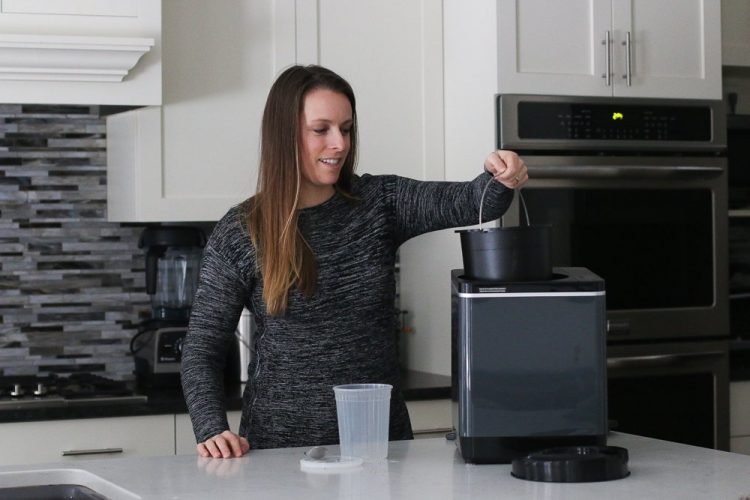
Use An Electric Composter
There are several electric compost appliances available. FoodCycler and Lomi are two of the most popular ones. I did a full review of the FoodCycler in 2021 (and not much has changed about it since then). I have a Lomi waiting also, so I will be sharing a review for that soon too.
Electric composters sit on your countertop or in a space near your kitchen. They are about the size of a small toaster oven. In the appliance bucket, you accumulate about a half-gallon of food scraps and then run the electric compost machine to break down the food scraps and turn them into soil amendment material.
Each of these machines works a little differently. Generally, however, they dry and then grind the compostable matter into a material that resembles something between dirt and potpourri. Certain systems claim you can add the finished material directly to house plants, gardens, and soil. Other systems require the finished material to reside in bare soil for several weeks before adding plants to ensure the material doesn’t overwhelm plant roots.
With any of these machines, you don’t have to use the material on plants or gardens. You could simply sprinkle it outside and let it feed nature over time.
This recommendation comes with a caveat. I only recommend this option if you will use the output effectively and in a way that you couldn’t do with the machine. After all, what’s the point of processing the food scraps if you’re just going to toss them in the trash, your compost bin, or your green bin for collection?
This is an easy way to compost, but it’s not a great option for most people. Be sure you really understand how this will fit into your life in a sustainable way before investing.
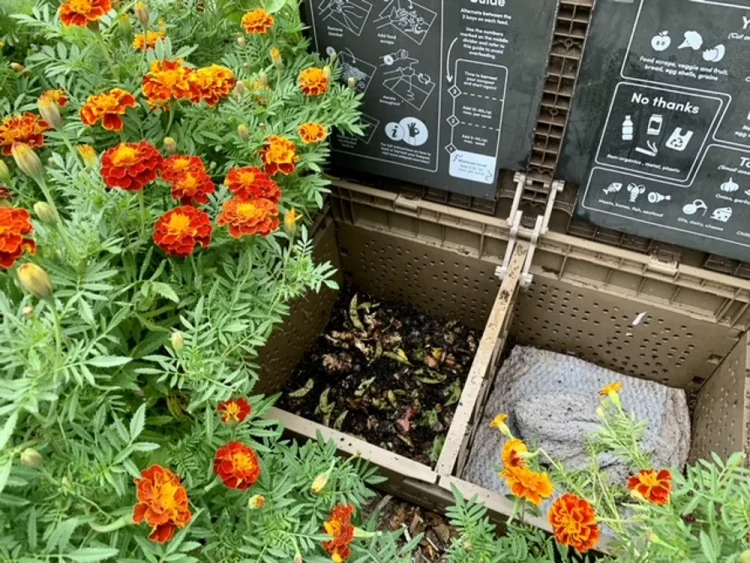
Set Up A Worm Bin (Indoor or Outdoor)
You could also consider vermicomposting, or composting using a worm bin. There are lots of different options, some more hands-on than others. It sounds more disgusting than it really is. And despite their small size, worms consume incredible amounts of food waste quickly.
Worm bins vary in size and functionality. Some work outdoors while others are built for indoor use. I think the two outdoor bins that are the easiest to use are the Hungry Bin and the Subpod. You can buy the Hungry Bin Flow-Through Worm Farm from Uncle Jim’s Worm Farm. I do not have a Hungry Bin, but you can see it in action on their site.
You can buy the Subpod here (we are an affiliate for Subpod, and you can get a 10% discount if you use the code HONESTLY10 to purchase a Subpod). I have a Subpod in a raised bed in my garden. It is quite easy to use and pretty easy to set up.
Further, here is a brief interview with a woman who uses a Subpod, so you can see it in action a bit. Subpod also has a community online where you can ask questions and get advice from other people on how they best manage their Subpod. This is a really helpful resource.
Use an Outdoor Compost Bin (I Like the Soil Saver The Best)
If you’re into getting your hands dirty, toning your arm muscles, and soaking up some time outdoors, the Soil Saver is definitely my favorite outdoor compost bin. You can find it under Outdoor Composters from Uncle Jim’s Worm Farm, one of my favorite and most trusted places to buy composting bins and tools (if we’re not getting them secondhand).
There are lots of other options for outdoor compost bins. You can find simple open bins that sit on the soil, enclosed tumblers that are raised off the soil, and many brands of enclosed bins that sit directly on the soil (like the Soil Saver).
After trying several different brands and types of bins and doing many interviews with people through the Compost Chronicles series, the Soil Saver is definitely our favorite outdoor bin. It’s sturdy, a good size, has doors at the bottom to access finished compost, locks tight on top to keep out animals, and allows rainwater to drain into the bin even when it’s closed.
I have found a couple of these secondhand on sites like Facebook Marketplace. I’ve also purchased one brand new from Uncle Jim’s Worm Farm, a local outdoor gardening and soil shop that I’ve really grown to like.
An outdoor open composting bin is a great option for composting, but it takes a bit of time to get it going and manage it properly.
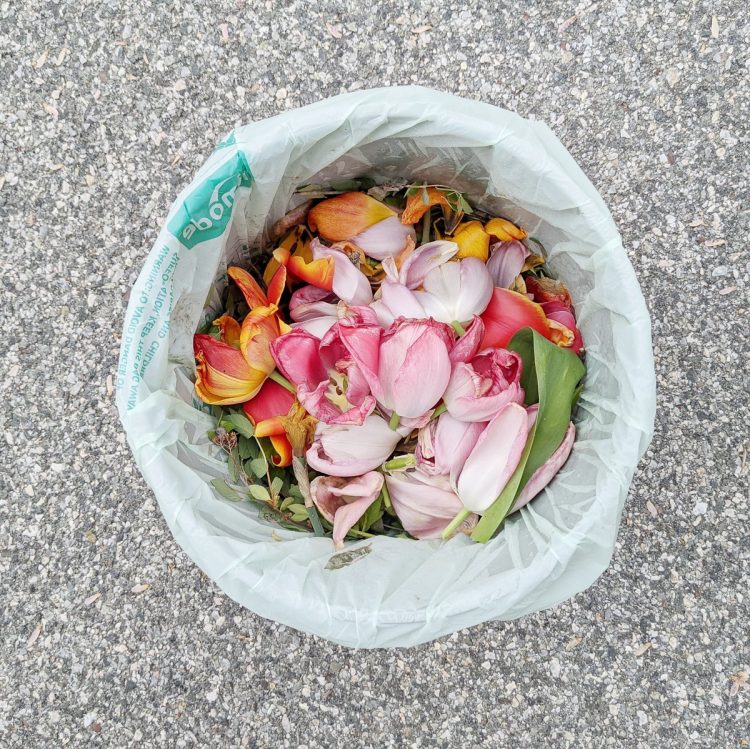
So there you have it. The long answer to one of the most common questions I get about how to start composting for beginners. If you’re thinking about composting, I would love to see you try one of these options and stop sending organic waste to landfills and incinerators.
If none of these options suit your fancy or you want even more details about each of them, check out 9 ways to compost in the suburbs and 6 ways to compost in an apartment or small space for more ways you can try composting at home.
How are you going to start composting at home? Let me know which option you think might work best for you.
Once you start composting, tossing that banana peel in the trash will never feel the same way again!


Jen Panaro
Jen Panaro, founder and editor-in-chief of Honestly Modern, is a self-proclaimed composting nerd and advocate for sustainable living for modern families. To find her latest work, subscribe to her newsletter, Stepping Stones.
In her spare time, she’s a serial library book borrower, a messy gardener, and a mom of two boys who spends a lot of time in hockey rinks and on baseball fields.
You can find more of her work at Raising Global Kidizens, an online space to help parents and caregivers raise the next generation of responsible global citizens.

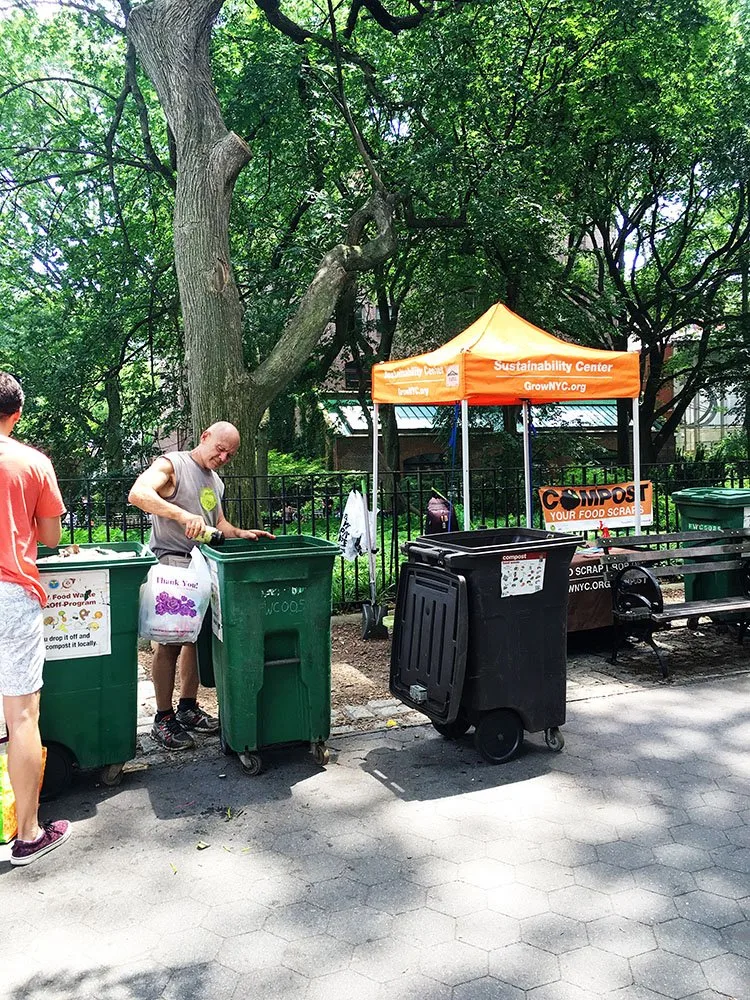
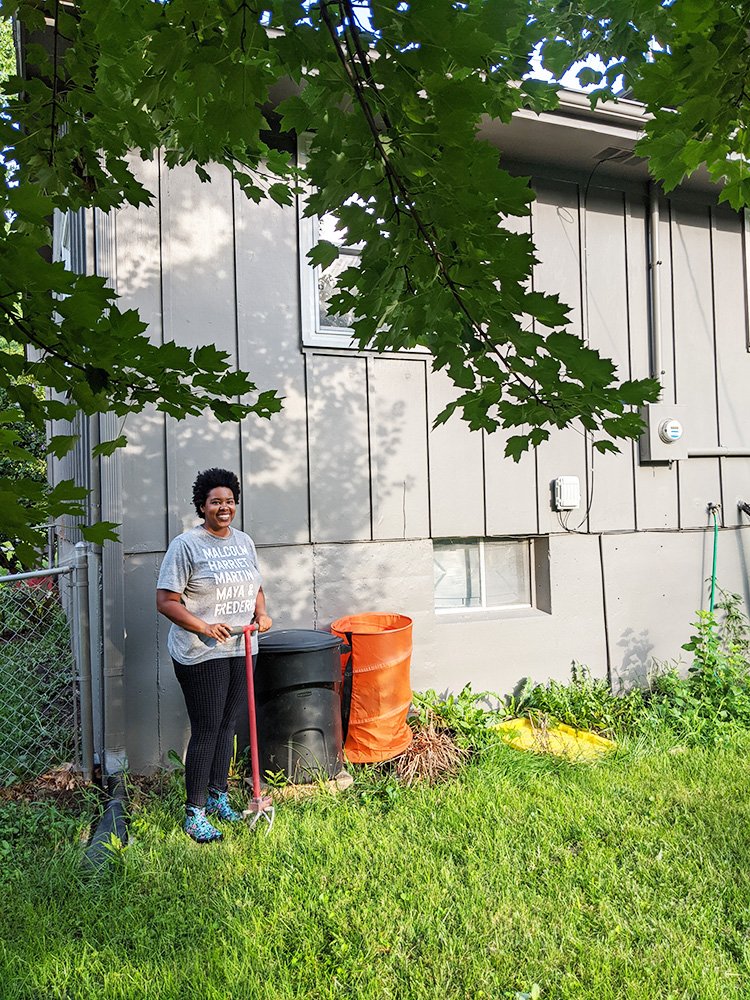
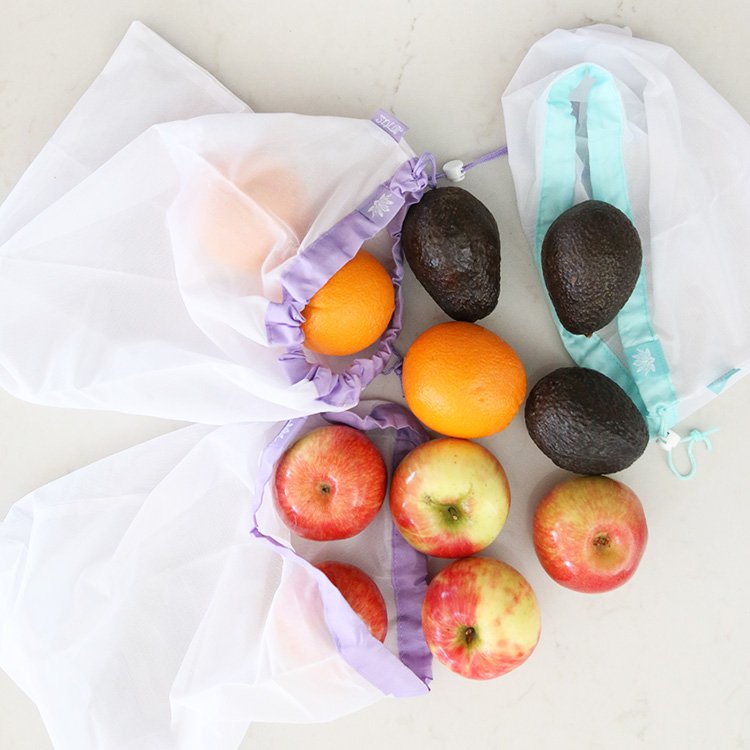
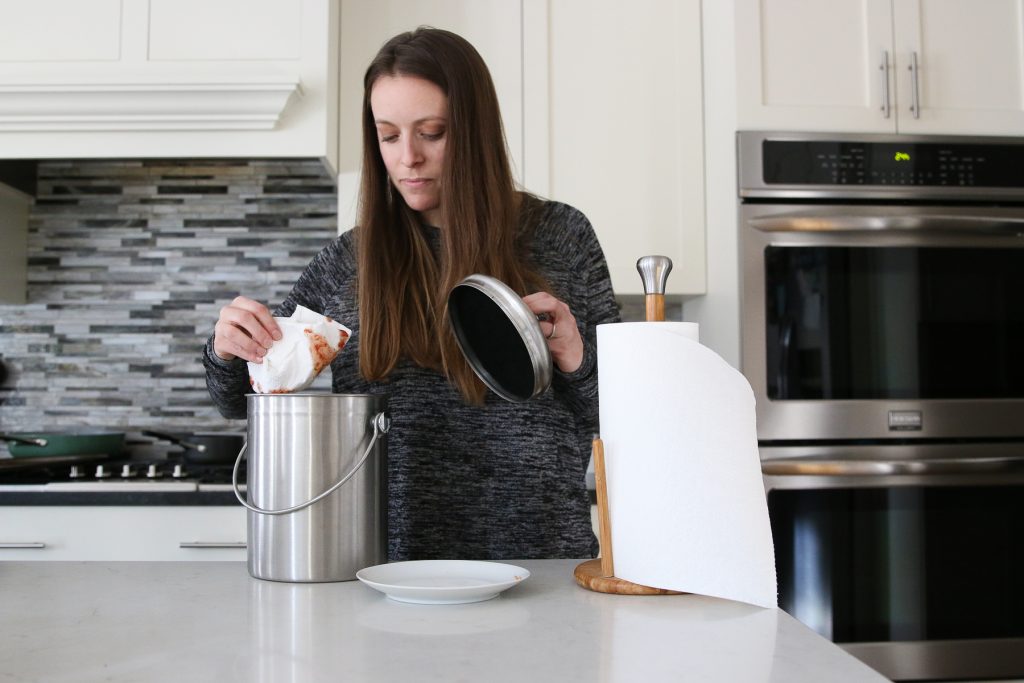
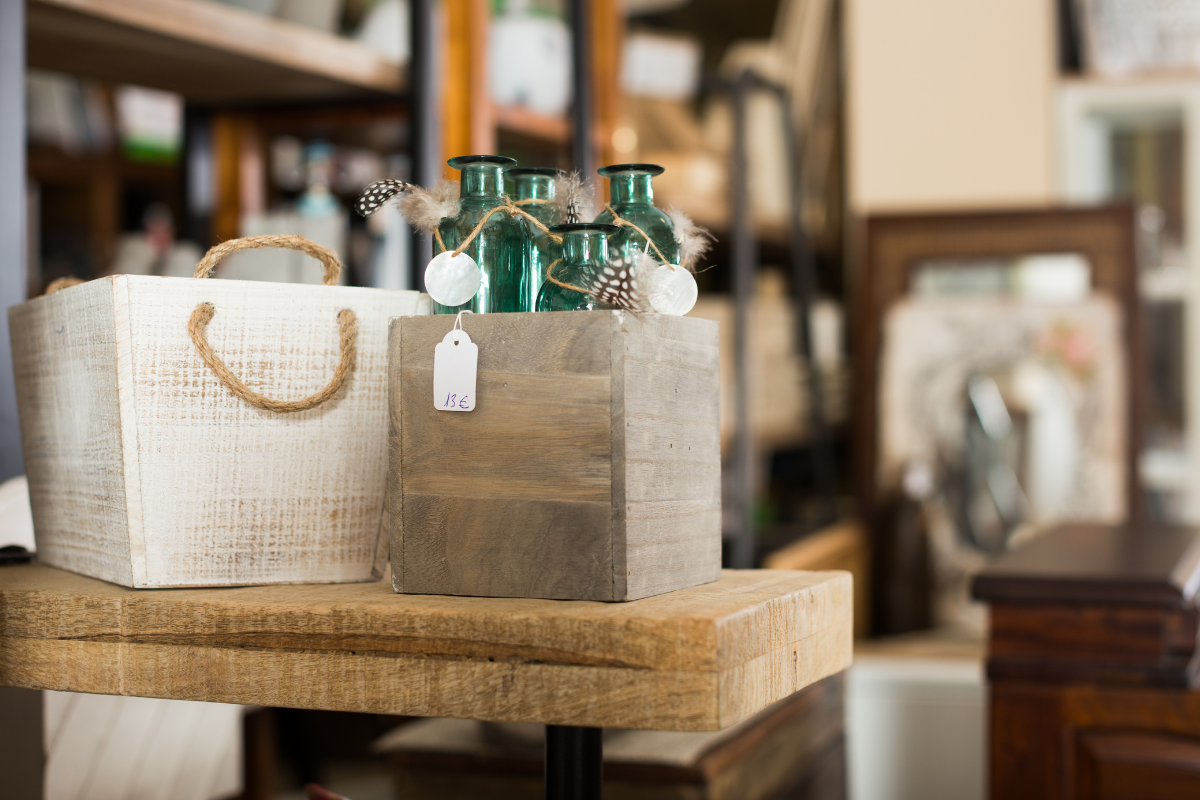
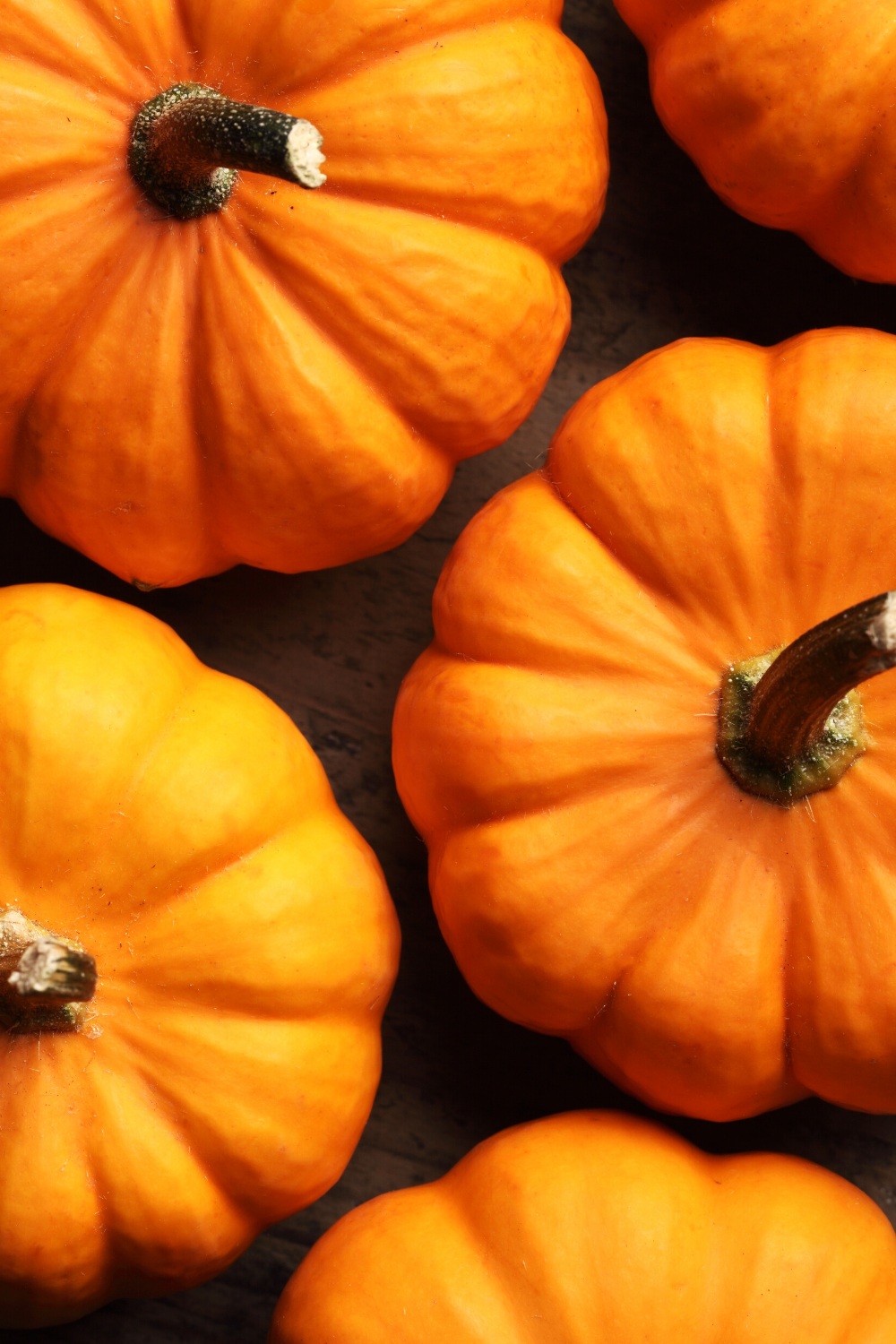

Hi Jen, I just read your post and you just saved me hundreds of $$.. I have the old style rolling barrel style composter that I’ve had for years and there may be old stuff still in it.:( I never could get the right amount of dry/wet combination to be successful. I just left it out back and would turn often and just leave it. I want to start using it again, but I am unsure where to start. I did put worms in it over a year ago and again left it. Please advise me how to get started and be able to product compost for my small garden. I live in a small city, no fear of critters around, so just a couple of old folks tired of throwing my fruit and veg scraps in the garbage. Please help if you can. Thanks Dawn
Hi Dawn – Thanks for the inquiry. Do you have a small space in your garden where you could move those food scraps from the rolling bin (maybe move them once or twice a year) into a bin that sits on the ground? It could be any container – an old trash can with the bottom removed, a compost bin, an old rain barrel, a DIY wood pallet compost enclosure? I find that the tumbler works well to get the scraps to breakdown enough that you can then toss them into something that has contact with the ground and the worms and microorganisms in the soil will take care of it from there with no smells or animal issues. I’ve really not had great luck getting a full compost cycle to compost in the tumbler. Second question – when you do leave it in the bin, do you have more trouble with it being too wet or too dry? – Jen